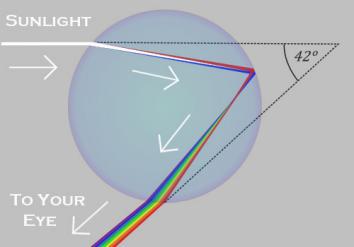Aysun Ülger is, like me, someone who loves atmospheric optical phenomena. Halos, glories, aurorae, iridescent clouds … so much so she created a Facebook page where she collects such photos. She just started it, but there are already a few lovely examples there.
And this includes, of course, rainbows. Since I just wrote about that very cool quadruple rainbow in New York, I thought I’d follow up with an example of a fun series of photos Ülger took herself in Izmir, Turkey: a rainbow rising as the Sun set!

Photo by Aysun Ülger, used by permission
Those were all taken on the same day, April 6, 2015, except for the bottom one, which she included in the series to show just how high a rainbow can get. In order (top to bottom), they were taken at 3:41, 3:50, 4:24, 4:50, 5:21, and 6:11 pm. The bottom one was taken at 5:58 pm on March 28. But due to a local time change, it corresponds to 6:58 on the later date.

Drawing by Wikipedia/KES47, adapted by Phil Plait
As I’ve written about many times, rainbows appear in the sky opposite the Sun—to see one, you have to stand with the Sun behind you. That’s because the light from the Sun bends inside the raindrop and is reflected on the drop’s backside, back toward the Sun. But not exactly: The light leaves the drop at an angle of about 138°. Only drops 42° away from the point in the sky directly opposite the Sun send that light toward you (180°–138°).
Also, the colors that make up the Sun’s white light get bent by slightly different amounts, spreading them out across the bow.
Since the arc of the rainbow is centered on the point on the sky directly opposite the Sun, a low Sun means a high rainbow, and a high Sun means a low rainbow. As Ülger waited, the Sun set, so the rainbow got higher. You can even see a double rainbow (called the secondary) and Alexander’s dark band, the darker region between the two bows.
Too bad she couldn’t get a time lapse of this! But she did point me to this one, which shows the increasing (more vertical) angle of the base of a very bright rainbow as the Sun lowers.
We get extremely bright rainbows in Colorado in the spring and summer, once afternoon rain showers clear out. They tend not to last very long, but still, next time I see one I’ll have to try getting a time lapse of it. That’ll be a fun project.